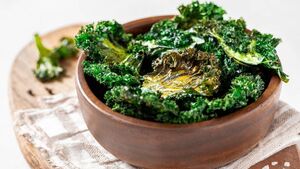Living Greener: Tasty kale crisps make for a healthy and tasty alternative

A sample of Kale Chips
IF there’s one ubiquitous food for children these days, it’s potato crisps – grownups give them to kids at parties, as a treat, as a snack or sometimes just because. If you don’t want your children to eat the fat and other unhealthy ingredients of processed food, you can make try something straight from the garden, something light, crispy, salty, but packed with vitamins. Take, for example, kale crisps.
Kale remains one of our hardiest crops, perhaps closest to the original seaside crop that gave rise to the whole cabbage family, from which gardeners bred cruciferous vegetables for their bus (Brussels sprouts), their heads (cabbage and bok choi), their roots (kohlrabi) and their flowers (broccoli, cauliflower).
One of the most nutritious of vegetables overall, 100 grams carries 50 calories but has 308 per cent of the day’s needed Vitamin A, 200 per cent of the needed Vitamin C and 1021 per cent of one’s daily needs of Vitamin K. It has high levels of calcium, iron, manganese and potassium.
Kale is also useful for when it appears; it can be grown and eaten year-round in our climate, but is especially productive when greens are needed, in the fall and winter. Kale can be sown from April to June – we put ours in small seed trays and keep them inside, and put them in the ground four to six weeks after they germinate. They need well-fertilised soil with a great deal of manure or compost added, but also need it to drain well.
To make kale into crisps, first snap some of the leaves off kale and bring it inside, remove the centre ribs and chop each leaf into several pieces. Wash them and let them dry – this will be the longest part, as they have to be completely dry to crisp up properly. I find it best to spin them and let them sit a few hours on a rack.
Pre-heat an oven to 150 degrees C. Put the kale in a dry bowl, drizzle a bit of olive oil over it and toss the kale until a thin layer of oil is coating everything. Line a baking tray with tinfoil and spread the kale over it, no more than one leaf thick. Cook for seven to ten minutes until crisp – they burn quickly, so keep checking on them.
Directions:
1. Preheat oven to 300 degrees Fahrenheit.
2. Wash kale leaves and dry very well.
3. Using a paring knife or kitchen scissors, trim out the ribs and discard. Cut the remaining kale into approximately two-inch pieces.
4. Place kale in a large bowl and toss gently but thoroughly, making sure that every last bit of kale leave is coated with olive oil.
5. Line a large baking sheet with parchment paper or a silicone baking mat. Lay kale in a single layer on the baking sheet and sprinkle with salt. (If you have more kale than baking sheet, you may need to cook them in batches).
6. Bake for eight - 12 minutes, just until crisp. Start checking at eight minutes - don't overcook or they'll burn! I find that Lacinato kale cooks faster than curly kale.
7. Remove from oven and let cool for a minute or two, then serve.
You can cook kale in many other ways; my favourite is probably the sweet-and-sour kale we make in our house. First lightly oil a pan and peel and dice a large onion. Toss the onion bits in and sautee them until they are yellow. Wash and chop about as much kale as will fit in a small pot – it will cook down, and the amounts don’t have to be precise --- and toss it in as well. Add a pinch of salt and stir frequently to make sure nothing sticks to the metal.
After the kale has shrunk and gone soft, drizzle it with several tablespoons of cider vinegar, and a tablespoon of honey, and stir it in. I like to add a bit of concentrated stock and cayenne pepper, or you can use balsamic vinegar to make it sweeter. These are general recipe outlines, of course -- see what formula you like best.






